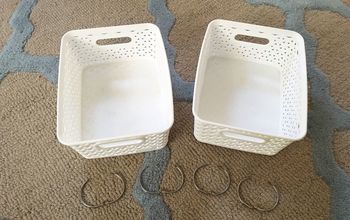How do I do Ceiling repair?

Related Discussions
Vinyl plank flooring vs pergo (laminate)
I currently have stinky dirty carpeting in my living room and I want to replace it with a durable flooring that can stand up to dogs and kids.
How to remove popcorn ceiling that has been painted?
Does having a paint over a popcorn ceiling change how I'd remove the popcorn ceiling?
How to apply peel and stick wallpaper?
I want to spruce up my walls with peel-and-stick wallpaper. Has anyone used this before and can advise me as to how to apply it properly?
How to stain wood floor?
I've heard staining is a good technique for updating floors. So how do I stain my wood floor?
How well do faux tin ceiling tiles work as backsplash? How do I clean
How do I update a sunshine ceiling without damaging it?
I would like to remove it and do something with the ceiling without damaging the surrounding area and put a new light fixture up.



looks to me the holes are small enough to simply fill with Plaster of Paris. You may have to apply 2-3 times. One to fill in the holes. The PofP will most likely shrink somewhat after dried. Then the second coat to smooth it out. This should work if the holes are 1" or less, which they appear to be.
After you fill in the holes you might consider those replica tin tiles (now of plastic) - some are ornate replicas with flourishes if you don't want a square. You might consider a mirror panel, the onews with the gold going through them light marble. Or anything that is relatively light-weight, that can be colored if need be... and there are some lovely textured wall papers that you could cut to any size and shape, or frame and attach for a visual interest.
Pick up some drywall repair tape from the hardware store. it will give you a surface for the spackle to grab. They also have a kit with everything included .
Make a "frame" out of pretty molding and attach it to the ceiling in this spot. Just be sure the frame covers the holes that are exposed. Paint the frame to match the ceiling and it will look like a decorative element.
My husband has a unique way of filling in larger holes which works beautifully. He cuts a piece of drywall about 1-2 inches larger than the hole to be filled. If the hole is larger than about 4-5 inches, he will attach a piece of lathe to the center (on the back side) so that it sticks out past the edges of the drywall to hold it in place. He then trims the plaster away from the patch to make the remaining plaster a snug fit into the hole. Once he has the patch ready, he coats the edges and bottom side of the 1-2 inch overhang (which has been stripped of plaster) and then places the patch into the hole. It should be flush with the surface, not pushed in. The overhand of paper on the front will allow you to adjust it's position. Then, adding more plaster over the edge of the patch, he will smooth the surface with his drywall blade. We usually let it dry for a couple of days due to the thickness and decreased air flow for drying. Then, apply plaster to the entire patch and surrounding area and smooth it out, let it dry, sand lightly and it's ready to prime and paint. You can't even tell the hole was there. I haven't seen it fail yet, in 20 yrs.
I appreciate all the suggestions, I not going to rush repair. Doing to right and with patience the first time sounds best. i appreciate creative insights.
Similar idea to Michelle's... cut a piece of drywall (or plywood) square, rectangular, or desired shape needed to cover the area. Attach to ceiling. Then use outside corner molding to frame/trim-out your piece. Looks really nice. We did this when removing cabinets from the ceiling which were blocking our view...